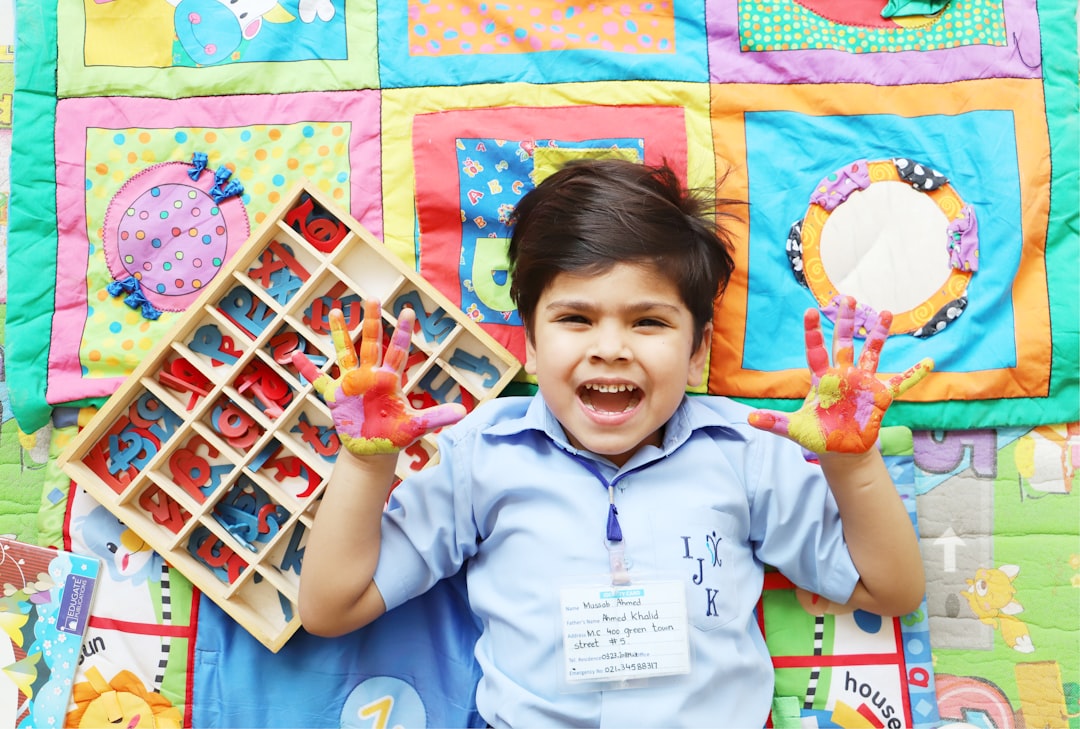

Engage prospects with a scan and streamline customer engagement with FREE QR code marketing tools by Sona – no strings attached!
Create a Free QR CodeFree consultation

No commitment

Engage prospects with a scan and streamline customer engagement with FREE QR code marketing tools by Sona – no strings attached!
Create a Free QR CodeFree consultation

No commitment
Child care services are at the heart of supporting early childhood development and enabling families to thrive in today’s fast-paced world. For providers, the challenge goes beyond simply meeting licensing standards. It is about engaging parents, streamlining processes, and earning trust in an increasingly competitive, tech-forward environment. Traditional analog workflows, such as paper sign-in sheets and printed forms, can lead to missed outreach and minimal insight into prospective families’ interests.
QR codes now bridge these gaps, transforming static physical touchpoints into dynamic digital experiences. In child care, QR codes enable effortless, contactless check-in, allow providers to capture high-value leads previously missed, and ensure feedback loops actually reach parents, directly impacting occupancy rates, satisfaction, and ongoing engagement. With a single scan, a parent can access enrollment forms, verify safety protocols, or submit real-time feedback, creating a seamless pathway from initial interest to ongoing engagement.
By thoughtfully integrating QR code solutions throughout daily operations, child care centers can automatically capture lead and engagement data that traditionally slips through the cracks, unify marketing and operational efforts, and surface previously invisible audience insights. The result: higher enrollment conversion, clearer insights into community needs, and opportunities for targeted follow-up that elevate both quality and competitive differentiation. For a deeper strategy on signals and segmentation, see Sona’s blog post titled the essential guide to intent data.

Child care providers frequently face the challenge of missed opportunities. Families may visit a facility or attend an open house but leave before completing enrollment or providing feedback. Paper forms often go unreturned, and signals such as interest in specific programs or tours are lost if not immediately captured. This lack of visibility results in underfilled classes, wasted marketing spend, and lost engagement with prospective families.
QR codes help solve these pain points by converting each offline interaction into a measurable digital step. When QR codes replace outdated forms or printed handouts, every scan becomes an actionable touchpoint: a chance to capture parent intent, track engagement, or automate lead entry into your CRM. This reduces friction throughout the enrollment process and ensures that high-value prospects who might otherwise remain anonymous are documented and nurtured efficiently.
For example, a center that shifts from paper to QR-enabled check-in and enrollment can quickly identify spikes in interest during open houses, attribute increased applications to specific event signage, and automatically follow up with families who showed intent but did not finalize enrollment. With dynamic QR codes and integrations through platforms like Sona QR, captured data can sync to your CRM for personalized follow-up, saving staff time and improving conversion rates.

A persistent challenge in child care is the inability to reach and nurture every family showing interest, especially those who interact with on-site materials or events but never complete a form. Providers often lack visibility into which parents are researching their services or what motivates final choices, resulting in missed opportunities and inconsistent communication.
QR codes turn static materials into measurable, interactive journeys. A quick scan connects parents to information and actions without requiring app installs or logins, capturing even casual interest at the moment it occurs. This creates a foundation for follow-up, allowing you to nurture leads who would otherwise remain anonymous.
Consider the parent who scans a poster at a local library or a QR on a neighbor’s referral card. With a single scan, their interest becomes measurable and actionable. You can capture intent, offer the right information, and invite them to book a tour or speak with a director, moving them naturally toward enrollment.

Child care centers interact with families across many touchpoints: drop-off routines, community events, and ongoing communications. QR codes can be tailored to each context to capture more value from every interaction.
Dynamic QR codes are especially effective because they allow you to change destinations, segment audiences by placement, and access richer analytics without reprinting physical materials. Static codes have a place for low-change assets like lunch menus or a staff directory PDF, but dynamic codes are better for campaigns, enrollment, and real-time updates.
With a centralized platform like Sona QR, you can generate these formats, manage them at scale, and tag each code by location or campaign to see which touchpoints convert best.

Many centers place flyers or rely on word-of-mouth without capturing who engages. QR codes help you identify where interest happens and convert that attention into applications or deeper involvement. By reviewing scan data, you can refine marketing spend, improve staff workflows, and adapt program offerings.
Strategic placement is critical. Think about where parents are already focused and what they need in that moment. Then give them a clear, useful next step with a concise call to action.
As scan data accumulates, you will see patterns in time of day, placement, and program interest. Double down on high-performing locations and messages, then retire or rethink those that underperform.

Child care centers benefit most when QR codes are placed at frequent interaction points, converting everyday moments into measurable progress toward enrollment, satisfaction, and compliance. Below are three core use cases that reliably move the needle.
Used together, these use cases transform scattered interest into a cohesive digital journey. Each scan supplies a data point that helps your team understand demand, tailor communication, and prioritize the highest-intent families.
Every QR scan is a signal. It captures context such as where the scan happened, when it occurred, and which message drove action. By deploying codes across multiple touchpoints, you can segment your audience and tailor follow-up to their stage in the journey and their specific interests.
This segmentation increases relevance and reduces wasted marketing spend. For more, see Sona’s Playbook titled intent-driven retargeting.
With Sona QR, each code becomes a smart entry point. You can centralize scans, tags, and journeys, then push segments to your marketing tools for precise nurturing and retargeting.
QR codes unify offline and online channels, helping families move seamlessly from discovery to decision while giving staff a simple way to capture and act on data. For more on the strategy, see Sona’s post, the essential guide to offline attribution. This is especially valuable in child care, where trust builds through in-person interactions but conversions often happen online.
When integrated thoughtfully, QR codes strengthen your entire marketing engine. They bring clarity to which materials perform and provide the agility to adapt messaging as needs change throughout the year.
Managed through a platform like Sona QR, all these touchpoints feed a centralized dashboard. You can monitor scan performance, attribute outcomes to specific materials, and sync data to your CRM for continuous optimization.
Launching QR initiatives without clear goals or follow-through leads to scattered data and limited impact. A disciplined approach ensures each scan serves a purpose, fuels your CRM, and moves families closer to enrollment. Start by clarifying what you want to change or improve. Then map your codes and placements to that objective, testing along the way to ensure a smooth experience for busy parents.
Below is a practical framework used by high-performing centers. Treat it like a loop: plan, deploy, measure, and refine. Over time, you will build a library of proven placements and landing pages that can be reused and adapted for future enrollment cycles.
Many centers struggle to connect specific marketing actions to actual enrollments. Without systematic tracking, it is difficult to refine strategy, prove ROI, or justify budget. QR codes change this by creating a measurable chain from interest to action, especially when paired with CRM integrations and clear attribution.
A strong analytics foundation starts with unique codes for each placement, followed by consistent naming conventions and UTM usage. From there, you can evaluate performance by channel and context, then shift resources toward the highest-impact activities.
Sona QR simplifies the process by centralizing codes, analytics, and integrations. With Sona, you can connect anonymous scans to known contacts using identity resolution and multi-touch attribution. This provides a holistic view from the first scan through to enrollment, helping you defend budget, optimize campaigns, and scale what works.
It is common to launch a few QR codes and then see engagement plateau. Usually the issue is not the technology, but the follow-through: unclear CTAs, limited staff promotion, or weak attribution. With a few practical adjustments, you can reignite momentum and keep performance compounding over time.
The most successful centers treat QR as a living system. They keep codes fresh, automate follow-ups, and educate staff so they can guide families toward the right next step. Here are actionable tips aligned to common child care contexts.
By implementing these practices and reviewing analytics monthly, you will keep improving scan rates, follow-up times, and ultimately enrollment conversions. Platforms like Sona QR can help manage these efforts with automated workflows, tags, and cross-channel reporting.
QR codes are rapidly transforming child care operations, bridging the gap between in-person community connection and digital-first engagement. Providers equipped with robust, integrated QR strategies consistently outperform on efficiency, safety, and enrollment growth, ensuring every parent interaction, from check-in to feedback survey, is both meaningful and measurable. Smart implementation provides new visibility into high-intent prospects, surfaces hidden churn risks, and synchronizes messaging with where each family stands on their journey. As the industry evolves, leveraging these digital connectors is no longer a luxury but a must-have for providers focused on long-term growth and quality excellence.
Adopting QR code technology represents a step change for child care services that empowers leadership to close gaps left by traditional workflows, minimize lost prospects, and bring every aspect of parent engagement into a unified, actionable framework. By equipping staff and streamlining family experiences, QR code solutions foster safer environments, more consistent communication, and stronger data-driven decision making. When backed by seamless CRM integration and analytics with platforms like Sona QR and Sona, each scan delivers insight you can act on, helping you increase occupancy, elevate service quality, and earn trust in your community. Start creating QR codes for free.
QR codes have revolutionized child care services by transforming routine communications into powerful, measurable engagement opportunities. Whether it’s streamlining parent check-ins, sharing real-time updates, or promoting enrollment campaigns, QR codes create seamless, interactive experiences that boost trust and drive conversions. Imagine instantly connecting with parents through a simple scan—capturing their interest and turning everyday interactions into lasting relationships.
With Sona QR, you gain the ability to craft dynamic, trackable QR codes that can be updated instantly without reprinting, giving you full control over your campaigns. Monitor which codes parents engage with most, optimize your outreach in real time, and directly link every scan to enrollment growth and revenue. No more guesswork—just smarter, data-driven strategies that elevate your child care services.
Start for free with Sona QR today and transform every scan into a meaningful connection and a step toward expanding your child care community.
QR codes transform static materials into interactive digital experiences that enable contactless check-in, capture parent intent, streamline enrollment, and facilitate real-time feedback, improving engagement and operational efficiency.
Using QR codes for check-in speeds up drop-off and pick-up processes, ensures consistent attendance records, supports health attestations for compliance, and reduces manual data entry and congestion.
By capturing high-value feedback through QR code surveys and review pages, centers can increase satisfaction scores, gather actionable insights, and close feedback loops that contribute to continuous quality improvement.
Effective strategies include placing QR codes on brochures, flyers, direct mail, event signage, and social media graphics with clear calls to action, using dynamic codes for real-time updates, tracking scan data for audience insights, and integrating with CRM for personalized follow-up.
Centers can increase enrollment by deploying QR codes linked to mobile-friendly enrollment forms, tour bookings, and subsidy information, automating lead capture and follow-up, reducing friction in the enrollment journey, and using analytics to optimize marketing efforts.
Use Sona QR's trackable codes to improve customer acquisition and engagement today.
Create Your FREE Trackable QR Code in SecondsJoin results-focused teams combining Sona Platform automation with advanced Google Ads strategies to scale lead generation

Connect your existing CRM

Free Account Enrichment

No setup fees
No commitment required

Free consultation

Get a custom Google Ads roadmap for your business






Launch campaigns that generate qualified leads in 30 days or less.
